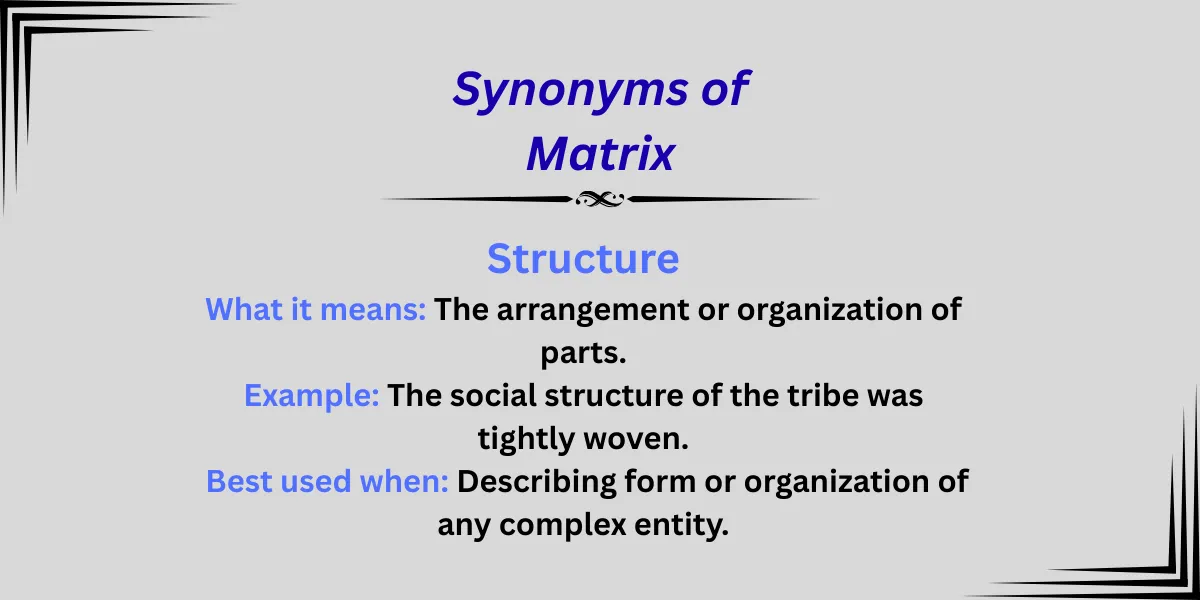The word “matrix” makes us think of something big, structured, or important. If you need synonyms of matrix, there are many words to choose from. A matrix can be a place or system where things grow. In math and science, it is a grid or table of parts. The word can feel technical, abstract, or even deep, depending on how you use it.
But matrix is not the only word for these ideas. In school, work, or creative writing, you may want a word that is simpler, clearer, or more vivid.
Below are 30 useful synonyms of matrix. Each word has examples and tips. You can use them in stories, science, or any writing to make your ideas clear and strong.
What Does “Matrix” Really Mean?
Before we jump into alternatives, let’s break down the core ideas behind “matrix”:
- Definition: A framework or environment where something forms, develops, or is embedded.
- Contexts: Math, biology, sci-fi, data science, philosophy, business systems.
- Tone: Formal, analytical, complex, abstract.
But not every situation calls for the same word. Let’s explore what to use instead—and when.
30 Synonyms of Matrix – With Usage Tips
1. Framework
What it means: A supporting structure or system.
Example: The new education framework encourages hands-on learning.
Best used when: Emphasizing structure, especially in planning or policy.
2. Structure
What it means: The arrangement or organization of parts.
Example: The social structure of the league was tightly woven.
Best used when: Describing the form or organization of any complex entity.
3. Grid
What it means: A pattern of intersecting lines or a layout.
Example: The city was designed on a perfect grid.
Best used when: Talking about layout, urban planning, or visual structure.
4. System
What it means: A group of interacting components.
Example: The nervous system is highly organized and responsive.
Best used when: Discussing interconnected parts, mechanical or social.
5. Network
What it means: A connected group of people or things.
Example: Her research is based on a network of ecological relationships.
Best used when: Referring to relationships, links, or connections.
6. Fabric
What it means: The underlying structure or makeup of something.
Example: The fabric of society is woven through culture and values.
Best used when: Writing poetically or emotionally about deep structures.
7. Foundation
What it means: The base on which something is built.
Example: Trust is the foundation of every lasting relationship.
Best used when: Emphasizing support or core principles.
8. Blueprint
What it means: A plan or detailed guide for construction.
Example: The blueprint for success includes discipline and persistence.
Best used when: Discussing planning or guiding systems.
9. Schema
What it means: A mental or conceptual framework.
Example: Children develop a schema for understanding emotions.
Best used when: Writing about psychology or cognitive development.
10. Model
What it means: A simplified representation of a system.
Example: The climate model predicts rising temperatures.
Best used when: Describing theoretical or predictive systems.
11. Configuration
What it means: The arrangement of parts in a system.
Example: The software’s default configuration may need tweaking.
Best used when: Discussing customizable or detailed setups.
12. Platform
What it means: A base for action, development, or exchange.
Example: Social media is a platform for public engagement.
Best used when: Referring to digital, political, or ideological bases.
13. Array
What it means: An ordered arrangement of elements.
Example: The lab used an array of sensors for data collection.
Best used when: Referring to data, tools, or visual layouts.
14. Composition
What it means: The makeup or structure of something.
Example: The chemical composition of the rock reveals its history.
Best used when: Discussing scientific or artistic structure.
15. Core
What it means: The central or most important part.
Example: Innovation is at the core of their business strategy.
Best used when: Highlighting a central idea or value.
16. Matrix System
What it means: A hybrid structure where elements belong to multiple groups.
Example: The company uses a matrix system to manage cross-functional teams.
Best used when: Talking about business or management models.
17. Lattice
What it means: A crisscrossed structure, often used in science.
Example: The crystal lattice gives the material its strength.
Best used when: Referring to physical or chemical structures.
18. Pattern
What it means: A repeated or consistent arrangement.
Example: Sleep patterns can impact mental health.
Best used when: Discussing trends, rhythms, or behaviors.
19. Layout
What it means: The way components are arranged.
Example: The website’s layout is clean and user-friendly.
Best used when: Talking about design or spatial arrangement.
20. Scaffold
What it means: A temporary structure that supports growth.
Example: The lesson plan provides a scaffold for student learning.
Best used when: Supporting ideas or development.
21. Form
What it means: The shape or structure of something.
Example: Her painting explores form and space.
Best used when: Writing about design, art, or abstraction.
22. Architecture
What it means: The design or structure of a system.
Example: The software’s architecture allows for modular updates.
Best used when: Discussing high-level design in tech or structure.
23. Cradle
What it means: The place where something begins or is nurtured.
Example: Greece is considered the cradle of Western civilization.
Best used when: Poetic or historical use for origins.
24. Construct
What it means: A conceptual or built framework.
Example: Gender can be understood as a social construct.
Best used when: Writing philosophically or sociologically.
25. Ecosystem
What it means: A system of interdependent elements.
Example: The startup thrives in a supportive tech ecosystem.
Best used when: Discussing innovation or collaborative environments.
26. Interface
What it means: A point of interaction between systems.
Example: The interface between human and machine is evolving.
Best used when: Talking about digital interaction.
27. Environment
What it means: The surrounding conditions or setting.
Example: The development environment is fully cloud-based.
Best used when: Describing software, biology, or growth spaces.
28. Mold
What it means: A shaped form into which something fits or grows.
Example: He broke the mold of traditional leadership.
Best used when: Writing creatively or metaphorically.
29. Design
What it means: The arrangement of elements in a purposeful way.
Example: The building’s design balances form and function.
Best used when: Describing intentional structure or aesthetics.
30. Medium
What it means: A channel or material for expression or development.
Example: Film is a powerful medium for storytelling.
Best used when: Referring to communication, expression, or transformation.
How to Choose the Right Synonym
Here’s a quick-reference table based on tone and use:
| If your tone is… | Use words like… |
| Formal/Scientific | Matrix, lattice, architecture, schema, configuration |
| Poetic/Philosophical | Fabric, cradle, mold, construct, medium |
| Business/Strategic | Framework, system, model, ecosystem, platform |
| Creative/Design-focused | Design, layout, form, pattern, blueprint |
| Tech/Data-centric | Grid, array, interface, core, digital environment |
Final Thoughts:
Using the right words can make your writing clear, strong, and easy to understand. A matrix shows a structure, system, or environment, but picking the best synonym can make your ideas sharper and more precise.
Now you know useful synonyms of matrix, each with examples and tips on how to use them. You can use these words in school, work, science, creative writing, or any project where you want your ideas to be simple and clear.
Keep this guide of synonyms of matrix close by. With the right word, your writing will always be clear, easy to read, and powerful. Choosing the best synonym helps your readers understand your ideas quickly and makes your writing shine.

